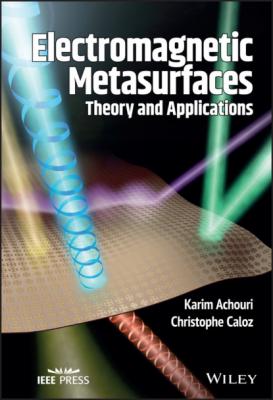alpha Over 2 EndFraction"/> is a coupling parameter associated to chirality [26, 155] and where the parameter
corresponds to artificial magnetism [122]. The constitutive relations (
2.37) reveal, via (
2.29), that chirality is related to spatial dispersion of the first order via
in
, while artificial magnetism is related to spatial dispersion of the second order via
. Both chirality and artificial magnetism depend on the excitation frequency via
. It may seem surprising that artificial magnetism is related to spatial dispersion but consider the following simple example, which is one of the easiest ways of creating an effective magnetic dipole. Consider, two small metal strips, one placed at a subwavelength distance
to the other in the direction of wave propagation. If the conditions are met, a mode with an odd current distribution may be excited on the strips resulting in an effective magnetic dipole. In that case, the electric field on one of the strip slightly differs from the one on the other strip since they are separated by a distance
, thus implying that the effective magnetic response of the strips spatially depends on the exciting electric field. If
, then the difference of the electric field on the strips would vanish as would the effective magnetic dipole moment.
It is not possible to further transform (2.37a) to eliminate the double spatial derivative associated with . However, it turns out that is most often negligible compared to and , as discussed in [29, 148], so that this term may generally be ignored. Solving then (2.37) for ultimately leads to the spatial-dispersion relations
(2.38a)
(2.38b)
where , , and , which are the isotropic (or biisotropic) counterparts of the bianisotropic constitutive relations (2.4).
Note that when , then and . This means that the permittivity and permeability have fundamentally different dispersive nature, a fact that has important consequences for metamaterials, as we will see throughout the book.
2.4 Lorentz Reciprocity Theorem
Reciprocity or nonreciprocity is a fundamental physical property of all media, structures, devices, and systems. “A nonreciprocal (reciprocal) system is defined as a system that exhibits different (same) received–transmitted field ratios when its source(s) and detector(s) are exchanged” [28].
A linear-time-invariant (LTI) system can be made nonreciprocal only via the application of an external bias field that is odd under time reversal, such as a magnetic field or a current. The most common example of a nonreciprocal device is the Faraday isolator, whose nonreciprocity is obtained by biasing a ferrite with an external static magnetic field [143].
This section derives the Lorentz reciprocity theorem for a bianisotropic LTI medium, which provides the general conditions for reciprocity in terms of susceptibility tensors. These relations naturally apply to LTI metasurfaces as well.
Let us consider a volume enclosed by a surface and containing the impressed electric and magnetic sources and , respectively. In the time-harmonic regime, these sources are related to the fields , , , and via Maxwell equations,
(2.39a)
(2.39b)
Similarly, the phase-conjugated impressed sources,5 and , are related to the phase-conjugated fields , , , and as
(2.40a)
